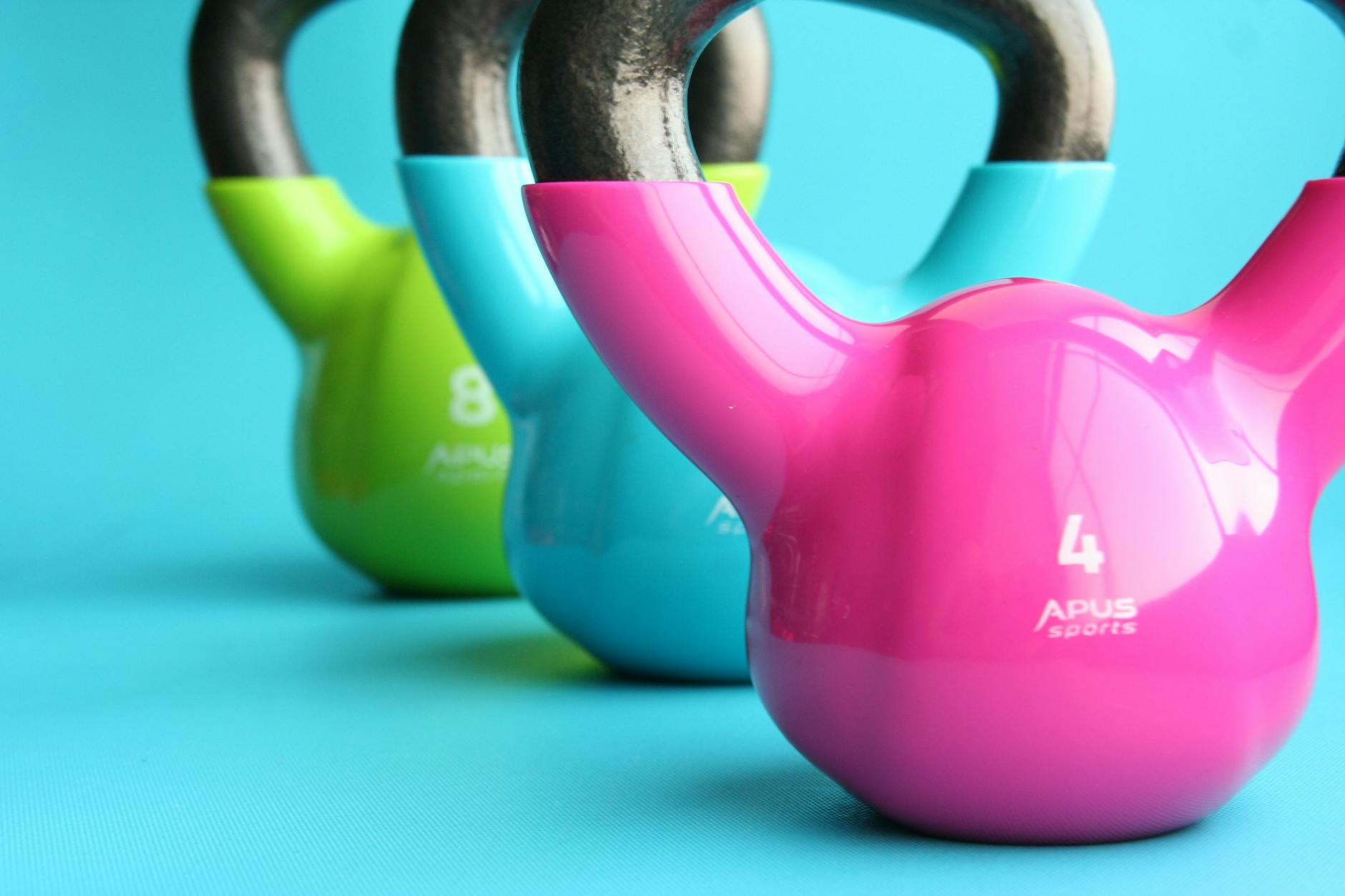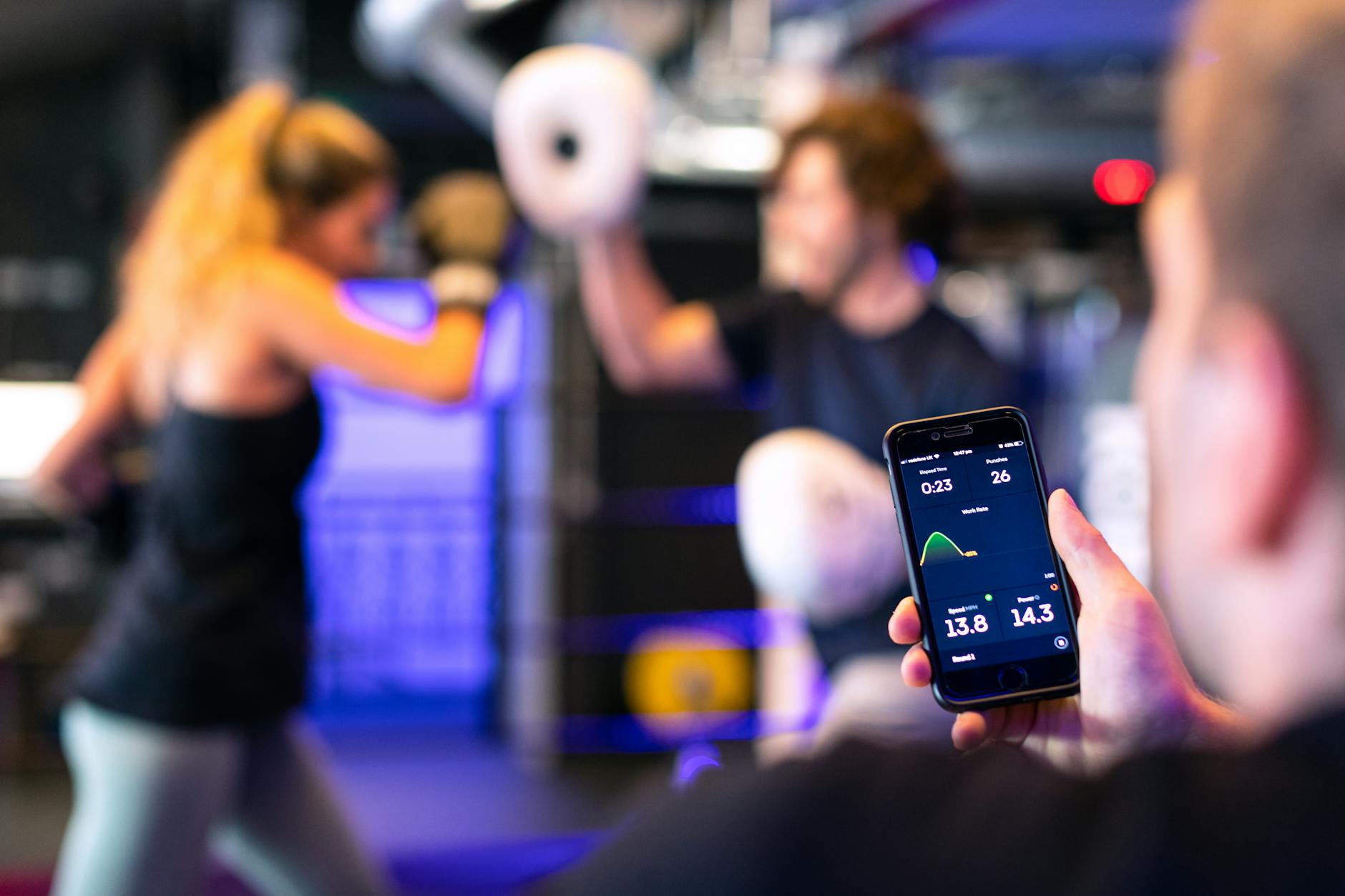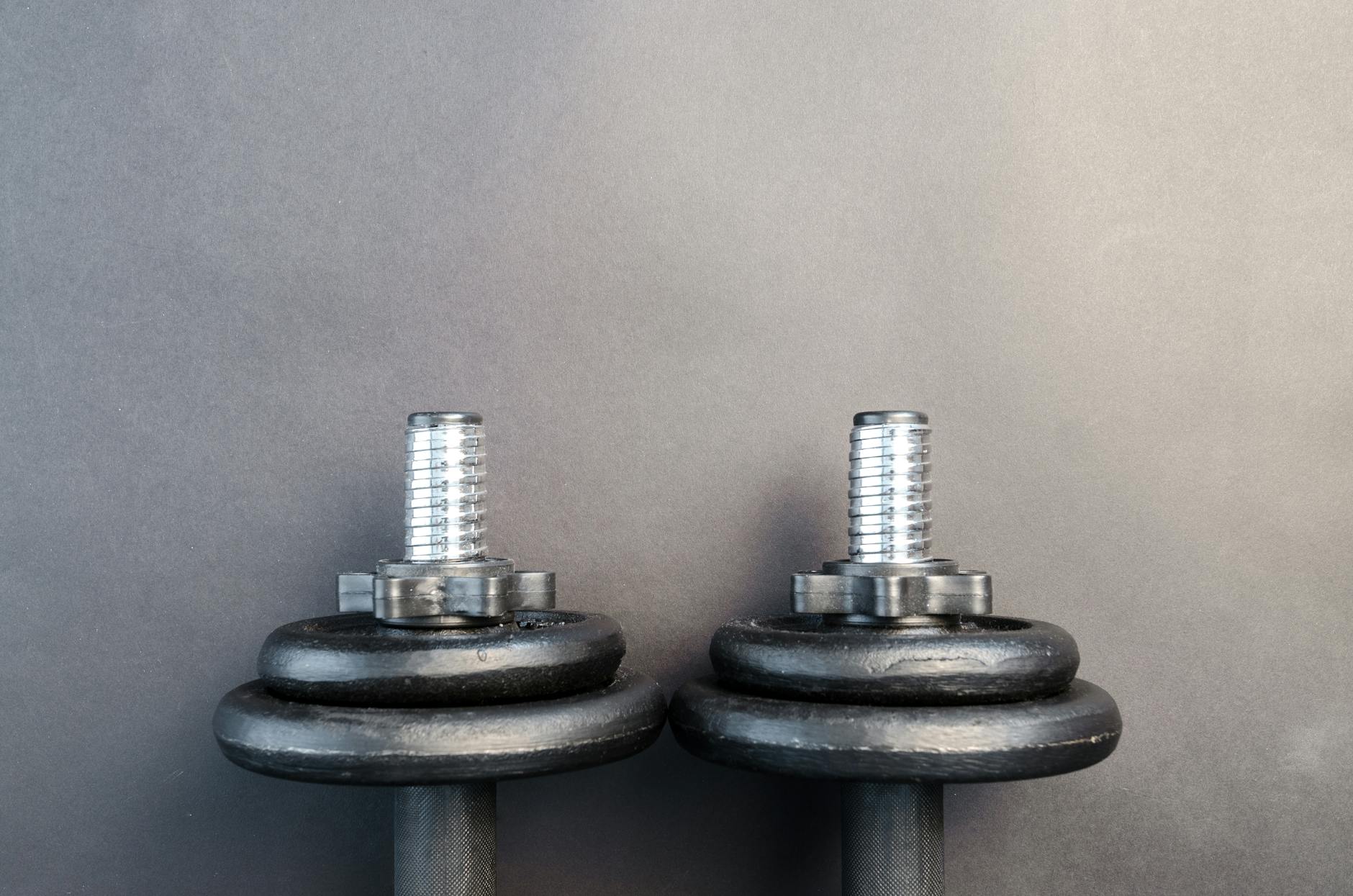If you are an enthusiastic fitness freak with a perfect home gym then, at that point, putting resources into an individual squat rack could be the best choice you will at any point make. Having one of the most incredible squat racks of 2021 will presumably be the most adaptable and simplest answer for moving forward your home rec center game. You’ll perform different activities to develop your muscles and increment your center strength like anything. This adaptable weight preparing gear permits you to do many activities like draw ups and seat presses, alongside a wide range of squats, no sweat. The most amazing aspect: you will actually want to quit emptying your cash into costly rec center participation subsequent to putting resources into the best squat rack. All in all, would you say you are likewise pondering purchasing this multi-skilled hardware for your home exercise center however not certain where to begin? No significant reason to stress. As always, we are here to help you get started. Below, we are sharing a list of our top 5 recommendations for the best squat rack out of all the hundreds available in the market. Also, we have compiled a super handy and detailed buying guide for you to make a convenient purchase.
Top 5 Best Adjustable Squat Rack
1. HulkFit Multi-Function Adjustable Power Rack Exercise Squat Stand
 HulkFit customizable squat racks are accessible in three choices; the 500 lb red and yellow rack, 800 lb limit squat rack and 1000 lb squat rack.For this audit we’ll take a gander at the 500lb red squat stand. This rack accompanies great highlights that permit you to do various sorts of activities from the solace of your home. It has J-snares and different extras that make your meetings simple. In contrast to other squat rack rec centers, this one has two weight plate holders. Comfort: First, the Hulfit squat stand sends pretty quick. You’ll be intrigued by the transportation time. It expects you to collect it and accompanies apparatuses and guidelines. Simple to-do.
HulkFit customizable squat racks are accessible in three choices; the 500 lb red and yellow rack, 800 lb limit squat rack and 1000 lb squat rack.For this audit we’ll take a gander at the 500lb red squat stand. This rack accompanies great highlights that permit you to do various sorts of activities from the solace of your home. It has J-snares and different extras that make your meetings simple. In contrast to other squat rack rec centers, this one has two weight plate holders. Comfort: First, the Hulfit squat stand sends pretty quick. You’ll be intrigued by the transportation time. It expects you to collect it and accompanies apparatuses and guidelines. Simple to-do.
Highlighting 11 check steel development, the HulkFit squat rack is strong and solid. The metal is covered with scratch safe and rust proof paint so you are guaranteed of the sturdiness of your rack. It highlights weight plate holders, so you can without much of a stretch add as you progress in your exercise venture. Max load limit: With this exercise center, your lifting needs are arranged. It has a 500 pounds weight limit, making ideal for most people.Also this rack accompanies stabilizers for solidness. I figure the maker ought to have quite recently included holds so one can bolt it to the floor for dependability.
It’s superior to the elastic end. Furthermore, the machine can be acclimated to your favored tallness and various situations since it has a draw up bar.
Aspects and capacity: The Hulk Fit squat stand has an element of 81″ x 50″ x 46″.and it gauges 120 pounds. This rack can fit at the rear of your vehicle without any problem. It’s additionally simple to store and move.
Key Features
- Steel
- Made in the USA or Imported
- Assembled dimensions: 81″ x 50″ x 46″. Product weight: 60 Pounds
- Pull up bar is included and can be mounted at your preferred height. Two heavy duty J-Hooks are included too
- Available in different colors, 2″ spacing hold pattern, all holes are numbered for easy recognition
- 500-Pound weight capacity. Heavy duty square steel frame construction with H-Shape base for max stability and safety
- Two weight plate holders are designed for convenience and enhanced stability. Assemble tools are included in the package
Pros
- It is easy to assemble
- Load capacity of 500 pounds
- Portable and has a pull-up bar
Cons
- It has small J-hooks
- Not ideal for weight above 500 pounds
2. Valor Fitness BD Independent Bench Press and Squat Rack Stands
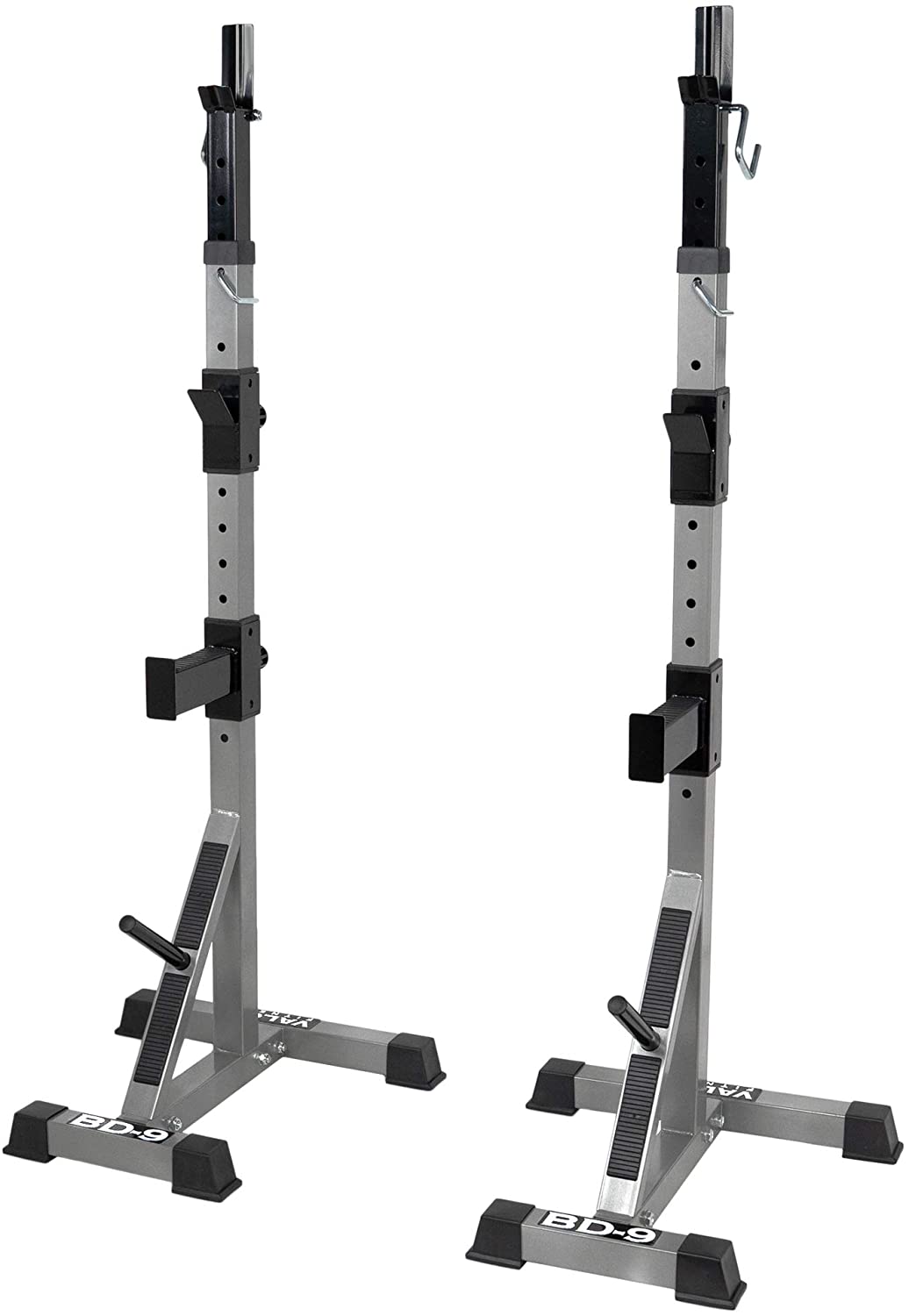 This squat stand is truly outstanding in the market with regards to security. In the event that you are a person who determines joy in preparing alone, this is a convenient solution for you. When properly introduced, it stays firm, which disposes of any type of dread that might emerge while seat squeezing. Likewise, as far as change of the bar stature, the interaction is exceptionally simple.
This squat stand is truly outstanding in the market with regards to security. In the event that you are a person who determines joy in preparing alone, this is a convenient solution for you. When properly introduced, it stays firm, which disposes of any type of dread that might emerge while seat squeezing. Likewise, as far as change of the bar stature, the interaction is exceptionally simple.
For the best outcome, ensure you reevaluate the bolts to guarantee they are as yet flawless whenever you have added weight to the stand.
Aside from giving strength and equilibrium to the hardware, very much fixed bolts additionally guarantee the bolt regions are shielded from uncommon wear. Establishment is simple and quick, so you needn’t bother with an uncommon manual or guide before you can associate various parts.
When contrasted with the first squat remaining on this rundown in quite a while of space needed for capacity, this gear doesn’t require enormous extra room.
With or without a substantial floor, it stays strong. This shows how solid and very much made it is. The security gets accompanied by cement elastic, which forestalls any type of scratch. Likewise, this gear isn’t without bar locks.
After a complete investigation of the item depiction, it seems like this hardware will be unable to deal with heavyweight. Likewise, except if you decide to hunch down the beneath position, which may here and there be hard to execute, this gear may not give you the best outcome for squat exercise. At the point when you take a gander at this item, generally speaking, it is a stunning purchase.
Key Features
- HEAVY DUTY: Constructed of 13-gauge steel with 2” x 2” tubing for strength and durability. Rubber end caps encase each foot for added stability and floor protection.
- ADJUSTABLE: Uprights adjust between 10 different heights from 49.5” to 75” tall. Also included are adjustable safety catches from 24.75” to 38.5” in 11 different positions.
- VERSATILE: Mainly functions as a squat stand, but with independent uprights it can easily accommodate a bench to perform bench presses. Storage pegs add functionality to the unit and make it more stable when loaded with plates.
- ADDITIONAL: Meant for home gym or light-commercial use. Max weight load of 350 lb. directed downward. Storage pegs compatible with EX-10 Olympic Adapter Sleeve
- EXPANDABLE FOOT BASE: 3 position adjustable base for larger footprint to add more stability. Minimum length of foot base is 20”, with a maximum of 28”.
Pros
- Affordable
- Offers flexibility
- The bar height is easy to adjust
- Doesn’t require a big storage space
Cons
- May not be able to handle the heavyweights
- May not give you the best result for squat exercise
3. Cap Barbell Power Rack
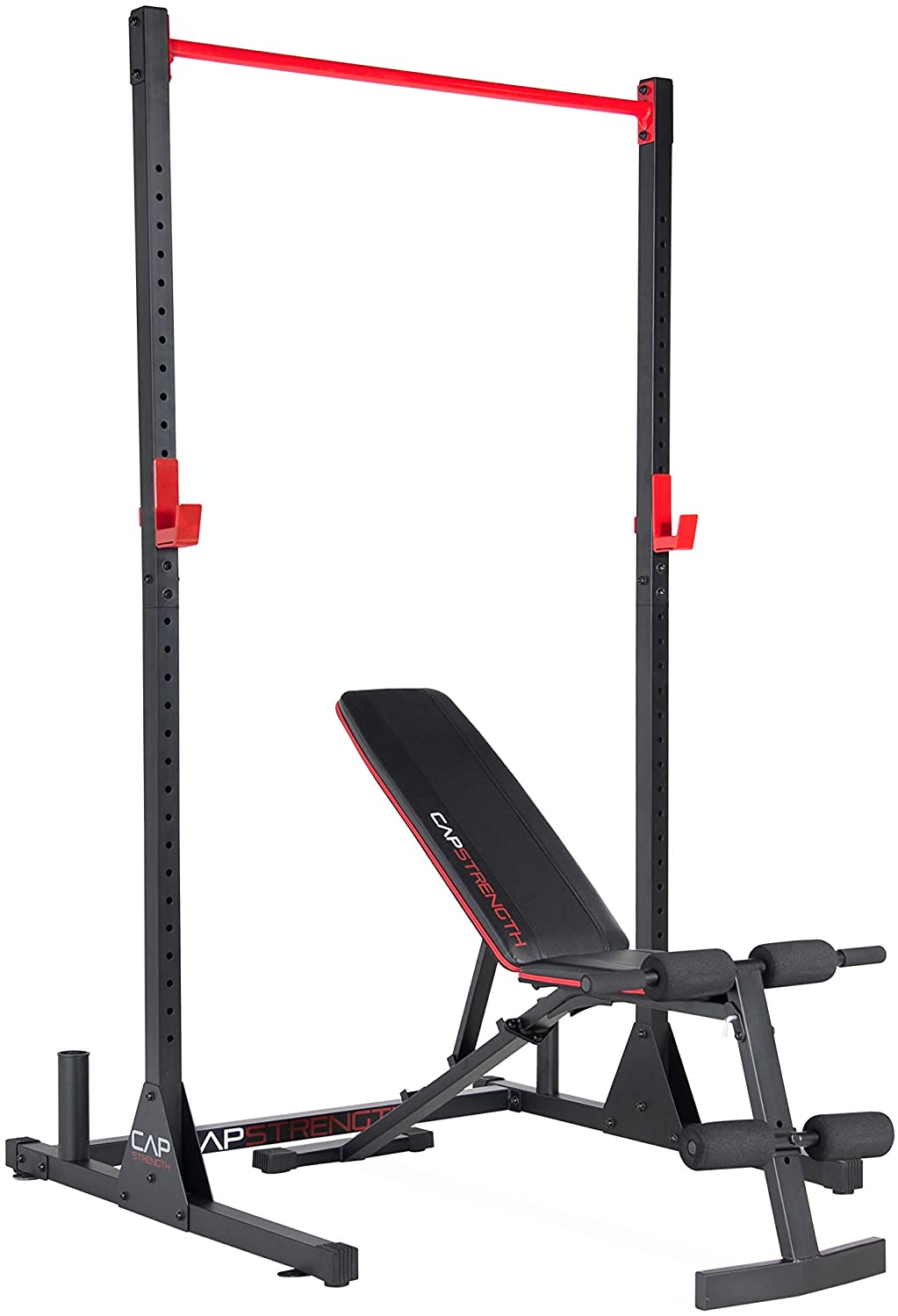 Made for various sorts of activities, the cap free weight power rack is an astutely planned home rec center squat rack that guarantees you get a decent exercise regardless of your wellness level. It is great for seat presses, weight lifting and plunges. Here are a portion of the motivations behind why you can’t turn out badly with this customizable squat rack. As a guideline, consistently go for a rack that has great surveys on its security. Also, in light of the many surveys on the web, this squat rack is ok for home use. Its casing is made of tough steel that backings up to 500 lbs. it accompanies an elastic finish to guarantee the rack is steady all through your meeting.
Made for various sorts of activities, the cap free weight power rack is an astutely planned home rec center squat rack that guarantees you get a decent exercise regardless of your wellness level. It is great for seat presses, weight lifting and plunges. Here are a portion of the motivations behind why you can’t turn out badly with this customizable squat rack. As a guideline, consistently go for a rack that has great surveys on its security. Also, in light of the many surveys on the web, this squat rack is ok for home use. Its casing is made of tough steel that backings up to 500 lbs. it accompanies an elastic finish to guarantee the rack is steady all through your meeting.
The elastic end additionally shields your floor from harm. The construction is intended to deal with all the maltreatment you toss in its direction. You need to guarantee your squat rack is secured in the event of harm. The Cap free weight squat rack accompanies a solid guarantee. Moreover, on the off chance that you are not happy with the machine, the brand will give a choice of purchasing another.
Key Features
- POWER RACK FEATURES: Adjustable j-cup bar catches & gusseted steel uprights offer versatility for full body workouts; Olympic bar & plate post offer ample storage; Rubber end caps prevent damage to floors; Floor anchors offer additional stability
- CONSTRUCTION: The Power Rack is constructed of 11- and 12-gauge steel and coated in a durable black and red powder coat; The Utility Bench is crafted from cold rolled steel tubing with a durable black powder coating
- FUNCTIONAL: Get in a full body workout with this power rack and bench combination. Perform bench presses, squats, core exercises, pull ups, and much more. Great for strength training, HIIT workouts, isolations and functional training
- UTILITY BENCH FEATURES: Perform upper body, lower body, and core exercises with the FOUR adjustable back pad positions; Foam rollers offer added comfort during core exercises; Comfortable yet firm padding; Rubber end caps prevent bench from moving
- SPECS: Power Rack Dimensions: 45. 47” L x 50. 59” W x 85. 43” H, Weight: 59. 5-lb, Weight capacity: 500-lb; Utility Bench Dimensions: 55. 12” L x 25. 39” W x 47. 24” H, Weight: 26. 46-lb; Weight capacity 500-lb; 30-day manufacturer’s
Pros
- Has a pull up bar
- It is easy to assemble
- This squat rack is multifunctional, allowing for different types of exercises
Cons
- Not ideal for floor bench press
4. Merax Adjustable Squat Stand
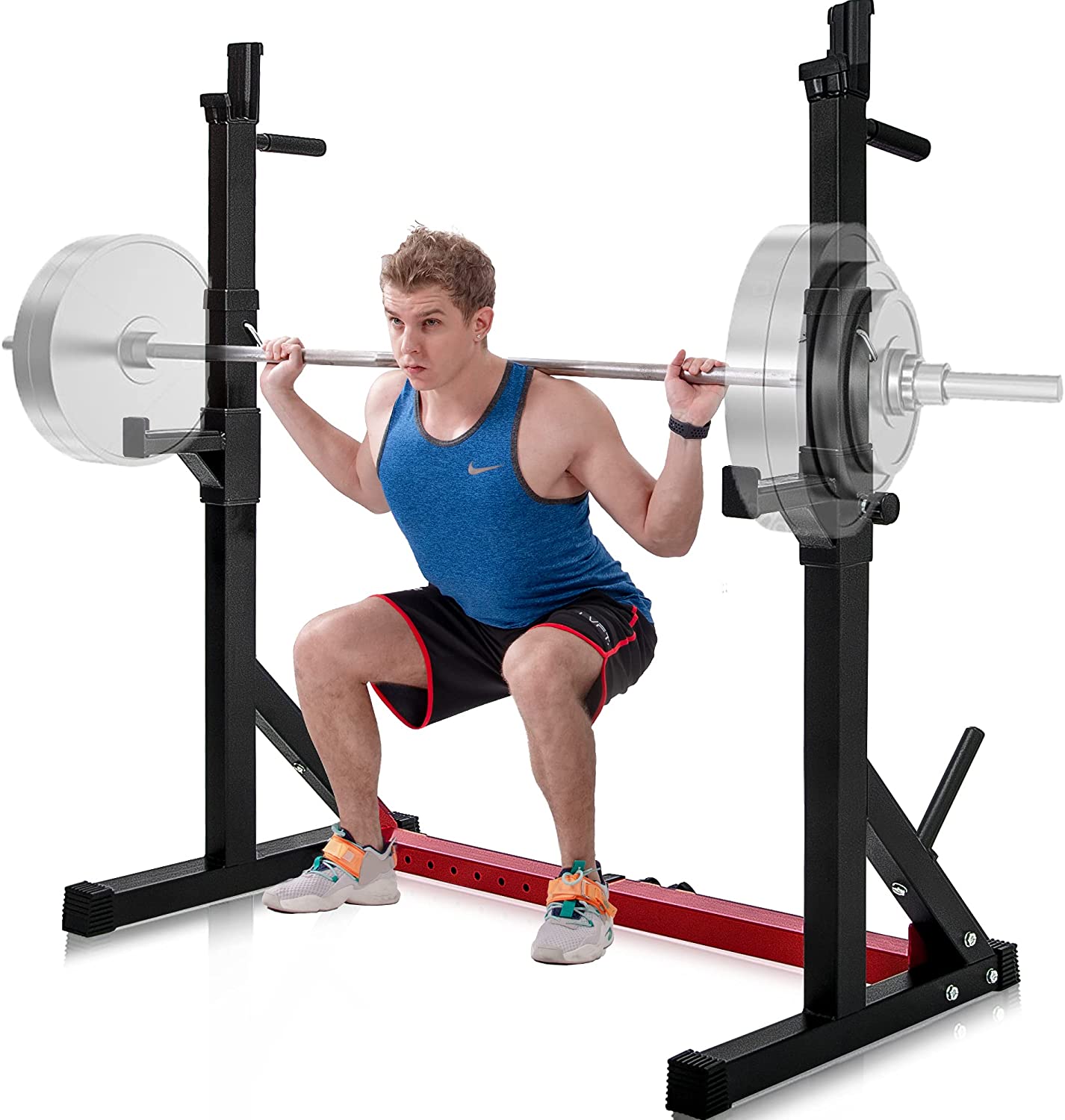 The Merax Adjustable Squat Stand is one of the most pursued power racks today. It brings three special elements to the table that oblige wellness lovers of various wellness levels. It is accessible in dark and red and will fit in a little space. It will help tone and fortify your muscles. Here is the reason you ought to go for the Merax squat stand.
The Merax Adjustable Squat Stand is one of the most pursued power racks today. It brings three special elements to the table that oblige wellness lovers of various wellness levels. It is accessible in dark and red and will fit in a little space. It will help tone and fortify your muscles. Here is the reason you ought to go for the Merax squat stand.
Merax rec center is customizable in 14 distinct positions. It has an opening separating two creeps on the bars. This empowers you to change it to the right tallness relying upon your exercises for the afternoon. You can do progressed plié squats and different sorts of squats, seat press, twists and then some. One reason you ought to go for this flexible squat stand is the maximum burden limit. It has a 550 lbs weight limit which is higher contrasted with other squat stands.
This squat machine is not difficult to store. It has two 8-inch stakes where you can store your weight plates. Also, the rack is lightweight and simple to move around. Nonetheless, I don’t care for the issue of setting up, I’m that languid, so I prescribe you put away sufficient room to leave it collected. Any home exercise machine ought to be solid and durable. You would rather not be nursing wounds and bring about clinical costs.The gear is built with uncompromising steel and it’s sufficient for a great many people. This makes it protected to utilize and it is additionally tough.
Key Features
- Weight Plates Storage: 8” length weight pegs on both sides provide convenient storage for standard weight plates, offering a compact solution for your home gyms, garage gym and fitness studios. The eye-catching red color of the base metal surely invigorates you and adds zest to your workouts.
- 550LBS Max Load: All-steel construction comes in effective and compact size, standing 5.6 ft, adjustable from 43.5” to 67.5”. Merax Barbell Rack impressively holds a max load of 550 LBS safe and secure.
- Squat Stand & Dip Station: The specially designed non-slip rubber boots keep the squat stand in place at all times, and protect your floor from scratches. This Barbell squat stand allows you to safely perform various exercises including bench press, shoulder press, squat, dip, overhead lifts and more.
- 13 Height Adjustment: with 2” hole spacing on the barbell rack uprights allows you to get the spotter arms customized at the exact height for doing squat, flat, incline and decline bench presses, curls, shrugs and much more.
- Compact Footprint: Merax Squat Rack assemble dimensions: 27.5”~45.5” (L) x 19.5”(W) x 43.5”~67.5” (H)
Pros
- It is strong and durable
- The Merax squat stand is easy to store and move
Cons
- Does not come with a bench
5. Uboway Adjustable Squat Stand
 The Uboway is a multifunctional squat stand that takes into account various sorts of activities to tone muscles in your chest, arms, abs and quads. It has a greatest burden limit of 550lbs and accompanies directions to assist you with making the best of your squat stand. This squat machine needs collecting and accompanies all the essential gathering instruments. Here are a portion of the reasons with regards to why you ought to think about getting it.
The Uboway is a multifunctional squat stand that takes into account various sorts of activities to tone muscles in your chest, arms, abs and quads. It has a greatest burden limit of 550lbs and accompanies directions to assist you with making the best of your squat stand. This squat machine needs collecting and accompanies all the essential gathering instruments. Here are a portion of the reasons with regards to why you ought to think about getting it.
You need a machine that functions as an across the board sort of machine. No compelling reason to purchase other hardware. The Uboway squat stand is an across the board sort of hardware. Uboway is adaptable and permits you to enhance your activities. It’s intended for completing a few activities including squats, shoulder and seat press, overhead lifts and plunges among others. This implies you can work your entire body while never going to the exercise center.
This squat rack machine has you canvassed as far as wellbeing. It has a T-formed base that makes it consistent and furthermore a square cylinder base that guarantees its stable.Additionally, the base holds well to the floor, so no wobbling or shaking. This gives you certainty while doing any type of activity.
It additionally accompanies its gathering devices so when it gets to your doorstep, you are all set. Perhaps add a chest expander so you can chip away at your six pack. For flexibility, this squat rack is stature movable from 36.2 – 55 inches, 12 distinct positions. This permits you to utilize the squat rack for various types of activities and furthermore clients of various statutes can utilize the rack easily.
Key Features
- STABLE & DURABLE: Heavy steel structure squat rack stand, barbell rack is made of high-quality steel that can hold a max load of 550 LBS safe and secure
- MULTI-FUNCTIONAL FITNESS: Squat machine equipped with 2 adjustable barbell storage racks. The multi-functional design allows you to easily do various exercises including bench press, shoulder press, squat, dip, overhead lifts and more
- ADJUSTABLE HEIGHT & WIDTH: Barbell rack stand with 12 adjustable heights(36.2-55.1inch) and 10 adjustable widths(24.8-42.9inch). A variety of combinations give you the most comfortable workout experience
- SECURITY SUPPORT: The Dip Bar Station base is T-shaped and not easy to turn over. The 2*2inch thick square tube used in the main frame enhances the stability of the entire barbell rack
Pros
- The machine is safe to use
- It is of high quality hence durable
- Ideal for core and arm strengthening exercises
Cons
- Not ideal for people over 6’
Conclusion
Since you have gone through our picks for the best squat rack, we trust you are completely prepared to make your first buy. These exercise center racks will be one of the main ventures of your life, so try to do it the correct way. Simply follow every one of the tips we have given above, and we guarantee that you will actually want to track down the best squat rack for your requirements. Likewise, we have suggested every one of the items in our rundown after intensive exploration, so you can have confidence about their quality. Regardless you pick, ensure it is an ideal best for you.
Frequently Asked Questions
1. Is a squat rack worth it?
If you’re powerlifting, weightlifting, or just straight-up want to move some weights, then yes, a rack is worth it. It offers safety, versatility, functionality, and straight-up allows you to lift some major pounds. As I always say, however, it only works if you use it, and it’s definitely only worth it if you plan on using it.
2. Do you need to bolt down the squat rack?
A squat rack should always be secured in place before use. Not doing so could result in unwanted rack movement or tipping. Bolting the rack to a lifting platform or the floor is the most secure option. If it can’t be bolted down, ensure the rack is heavily weighted and has a wide base for stability.
3. How high should a squat rack be?
The bar should be racked slightly lower than shoulder height. This means that when you come to unrack the bar, you don’t need to dangerously go up onto tiptoes. The bar should be placed centrally on the rack. The spotter bars should be set at around 1-inch lower than your fail height.
4. How long does the squat rack last?
You should also consider the amount of weight and frequency of use that the squat rack will see. But do not only plan based on how much you lift now, plan based on how much you plan to live 3, 5, and even 10 years from now. A squat rack, due to the nature of the build quality, is designed to last for many decades.
5. How much should you spend on a squat rack?
If you are tight on budget, we would recommend you to spend at least $400 to buy the best squat rack. On the other hand, if you have an open budget and are looking for something extravagant, $1000 – $1500 would be enough! Not really. The safety of the best squat rack doesn’t rely on its price but on its quality.
6. Are power racks safe?
The power racks are made using heavy-duty steel tubes. It normally has a weight capacity of over and above 800 pounds. Such strong construction and huge weight-bearing capacity make it safe to be used with heavy loads. The base of the rack is solid enough to take care of all the load and movement.
7. What is a hack squat?
The hack squat involves standing on the plate, leaning back onto the pads at an angle, with the weight placed on top of you by positioning yourself under the shoulder pads. The weight is then pushed in the concentric phase of the squat. Simply put, when you stand back up, that’s when the weight is pushed away from you.
8. Do you need to bolt down the squat rack?
A squat rack should always be secured in place before use. Not doing so could result in unwanted rack movement or tipping. Bolting the rack to a lifting platform or the floor is the most secure option. If it can’t be bolted down, ensure the rack is heavily weighted and has a wide base for stability.
Discover how these simple beginner workouts can kickstart your fitness journey and set you up for success in reaching your goals.
Table of Contents
Whether you’re a fitness novice looking to kickstart your wellness journey or a seasoned gym-goer searching for ways to enhance your workouts, combining proper workout techniques, nutrition, and a well-thought-out gym plan is essential for achieving optimal fitness results. In this guide, we will walk you through step-by-step on how to maximize your gym sessions and reach your fitness goals.
Setting Fitness Goals
Before diving into a workout routine, it’s crucial to establish clear fitness goals. Take some time to reflect on what you want to achieve – whether it’s shedding pounds, building muscle, increasing strength, or improving overall health. Make sure your goals are SMART: specific, measurable, achievable, relevant, and time-bound. This will help you stay focused and motivated throughout your fitness journey.
Workout Plan
Creating a well-rounded workout plan is the foundation of any successful fitness regimen. Incorporate a mix of cardio, strength training, and flexibility exercises to target all areas of your body. Don’t forget to include rest days in your schedule to allow your muscles time to recover and rebuild. Consistency is key, so stick to your plan and make adjustments as needed.
Nutrition Plan
A balanced diet plays a crucial role in supporting your fitness goals. Aim to eat a variety of nutrient-dense foods, including lean proteins, complex carbohydrates, healthy fats, and plenty of fruits and vegetables. Stay hydrated by drinking enough water throughout the day and avoid sugary drinks and processed foods that can hinder your progress. Remember, what you eat is just as important as how you move.
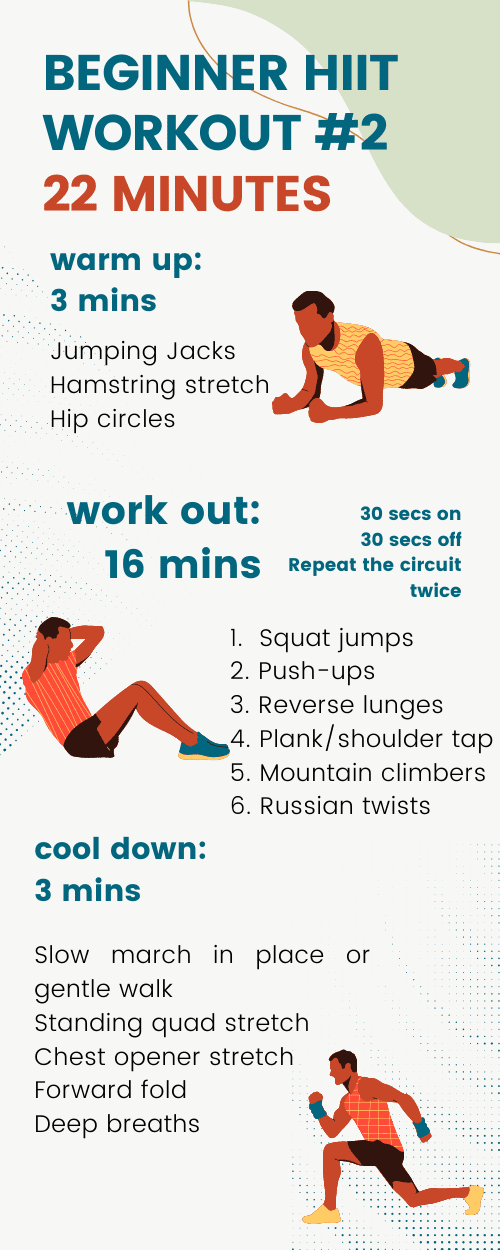
Image courtesy of hiitathome.co.uk via Google Images
Pre-Workout Nutrition
Fueling your body before a workout is essential for providing energy and enhancing performance. Consume a light snack or meal containing a mix of protein and carbohydrates 1-2 hours before hitting the gym. This will help sustain your energy levels and optimize your workout results. Good pre-workout nutrition sets the stage for a successful training session.
Post-Workout Nutrition
After you finish your workout, refuel your body with a meal or snack rich in protein and carbohydrates within 30 minutes. This post-workout nutrition is vital for replenishing glycogen stores, repairing muscle tissue, and promoting recovery. Don’t forget to hydrate with water to replace lost fluids and electrolytes. Proper nutrition after a workout will help you bounce back stronger for your next session.

Image courtesy of www.linkedin.com via Google Images
Gym Tips
At the gym, ensure you start with a proper warm-up routine to prepare your body for exercise and reduce the risk of injury. Utilize a variety of gym equipment and exercises to target different muscle groups and keep your workouts engaging. Remember to maintain good form and technique to maximize the effectiveness of your workouts while minimizing the risk of strains or sprains.
Recovery
Recovery is just as crucial as exercise when it comes to achieving fitness goals. Allocate time post-workout to stretch and cool down to aid in muscle recovery and flexibility. Prioritize getting enough rest and sleep to give your body time to repair and grow stronger. Listen to your body’s signals and adjust your workout intensity or frequency if needed to prevent overtraining and burnout.

Image courtesy of www.linkedin.com via Google Images
Progress Tracking
Keep track of your progress by maintaining a workout and nutrition journal. Record your exercises, meals, and how you feel after each workout to monitor improvements over time. Consider taking progress photos or measurements to visually track changes in your physique. Celebrate small victories and milestones along your fitness journey to stay motivated and committed to your goals.
Consistency and Patience
Results in fitness take time, so stay consistent with your workout routine and nutrition plan. Be patient with your progress and remember that sustainable changes don’t happen overnight. Focus on making small, consistent steps towards your goals and trust the process. Celebrate the small wins along the way to maintain motivation and momentum towards your ultimate fitness goals.

Image courtesy of www.linkedin.com via Google Images
Conclusion
By following these tips and incorporating them into your fitness routine, you can maximize your gym workouts for optimal results. Remember, fitness is a journey, not a destination. Stay committed, stay focused, and most importantly, listen to your body. With dedication and consistency, you’ll be well on your way to achieving your fitness goals and living a healthier, happier life.
Discover the secrets to unlocking a happier mind and a healthier life in this comprehensive guide to mental wellness.
Table of Contents
Are you looking to enhance your overall well-being and achieve optimal health? Incorporating workouts, nutrition, and gym plans into your daily routine is a crucial step towards achieving this goal. This comprehensive guide will provide you with practical tips and strategies to help you navigate the world of physical activity, healthy eating, and gym memberships.
Workouts
Regular physical activity is essential for maintaining good health and improving your fitness levels. Whether you prefer cardio, strength training, or flexibility exercises, finding a workout routine that suits your lifestyle is key. Consider incorporating a mix of different types of workouts to keep things interesting and challenging.
Nutrition
Proper nutrition plays a vital role in supporting your overall health and well-being. Ensure that your diet includes essential nutrients such as vitamins, minerals, protein, and healthy fats. Meal planning and portion control are key strategies for maintaining a balanced diet that supports your fitness goals.
Gym Plans
Joining a gym or fitness center can provide you with access to a wide range of equipment and resources to support your fitness journey. When choosing a gym, consider factors such as location, class offerings, and equipment availability. Sample gym workout plans for individuals of different fitness levels can help you get started on the right track.

Image courtesy of www.seafarerswelfare.org via Google Images
Combining Workouts and Nutrition
Workouts and nutrition go hand in hand when it comes to achieving optimal health. Fueling your body with the right nutrients before and after workouts can help you maximize your performance and recovery. By combining effective workouts with a balanced diet, you can take your fitness goals to the next level.
Setting Realistic Goals
Setting achievable goals is essential for staying motivated and committed to your health and fitness journey. Whether you’re aiming to lose weight, build muscle, or improve your overall fitness, having clear goals in mind can help you track your progress and stay on course.

Image courtesy of www.australiawidefirstaid.com.au via Google Images
Key Health Tips
Hydration, sleep, and stress management are all crucial aspects of maintaining good health. Drinking an adequate amount of water, getting enough rest for recovery, and finding ways to manage stress can all contribute to your overall well-being. Incorporating these key health tips into your daily routine can help support your fitness goals.
Tracking Progress
Monitoring your workouts, nutrition, and progress is a valuable tool for staying on track with your health and fitness goals. There are a variety of tools and apps available that can help you track your activity levels, food intake, and progress over time. By staying consistent with tracking your progress, you can identify areas for improvement and celebrate your achievements along the way.

Image courtesy of venngage.com via Google Images
Modifications for Specific Goals
Whether you’re aiming to lose weight, gain muscle, or achieve specific fitness goals, there are adjustments you can make to your workouts and nutrition to support your objectives. Tailoring your approach to meet your individual goals can help you stay focused and motivated as you work towards achieving your desired outcomes.
By following this ultimate guide to workouts, nutrition, and gym plans, you can take a proactive step towards improving your overall health and well-being. Remember that prioritizing your health is an ongoing journey that requires dedication, commitment, and a willingness to make positive changes in your daily routine. By incorporating these strategies into your lifestyle, you can achieve lasting results and enjoy the many benefits of a healthier, happier you.
Discover the secrets to burning fat and building muscle with these powerful workouts designed specifically for women’s fitness goals.
Table of Contents
Ensuring a healthy lifestyle through exercise and proper nutrition is essential for both physical and mental well-being. One of the key components of maintaining good health is incorporating regular workouts and a balanced diet into your routine. For women looking to burn fat and build muscle, a strategic workout plan and nutritious eating habits are crucial. In this blog post, we will provide you with a comprehensive guide on how to stay healthy with effective workout and nutrition tips.
Setting Up Your Gym Plan
Determining your fitness goals is the first step in creating a successful gym plan. Whether you aim to lose weight, gain muscle, or improve your overall fitness levels, setting clear objectives will help you stay motivated and focused. Once you have established your goals, you can create a workout schedule that fits your lifestyle and preferences. This could involve allocating specific days for cardiovascular exercise, strength training, and rest.
Incorporating Cardiovascular Exercise
Cardiovascular exercise is essential for burning calories and improving heart health. There are various forms of cardio workouts to choose from, including running, cycling, swimming, and high-intensity interval training (HIIT). To effectively incorporate cardio into your gym plan, aim to engage in at least 150 minutes of moderate-intensity cardio each week. Adjust the frequency and duration of your cardio sessions based on your fitness level and goals.
Strength Training for Building Muscle
Strength training plays a crucial role in building muscle mass and boosting metabolism. Women often fear that lifting weights will make them bulk up, but in reality, it helps to tone and sculpt the body. Incorporate a combination of free weight exercises, machine workouts, and bodyweight movements into your gym plan to target different muscle groups. Aim to strength train at least two to three times a week, focusing on exercises that challenge your muscles and allow for progression.

Image courtesy of www.pinterest.com via Google Images
Proper Nutrition for Fueling Your Workouts
Eating a balanced diet is essential for fueling your workouts and supporting your fitness goals. Ensure that your meals consist of whole foods such as fruits, vegetables, lean proteins, whole grains, and healthy fats. Prioritize pre- and post-workout nutrition by consuming a mix of carbohydrates and protein to provide energy and aid in muscle recovery. Avoid processed foods and sugary snacks, opting for nutrient-dense choices that promote overall health.
Hydration and Its Role in Fitness
Staying hydrated is key to maintaining optimal performance during workouts. Water helps regulate body temperature, transport nutrients, and lubricate joints. Aim to drink at least eight glasses of water per day, adjusting your intake based on your activity level and sweat rate. Carry a water bottle with you at all times to ensure you stay hydrated throughout the day and during your gym sessions.

Image courtesy of www.pinterest.com via Google Images
Rest and Recovery
Rest and recovery are essential components of any workout plan. Overtraining can lead to burnout, injury, and a plateau in progress. Incorporate rest days into your schedule to allow your muscles to recover and grow. Focus on getting an adequate amount of sleep each night, practicing stretching and foam rolling to alleviate muscle soreness, and listening to your body for signs of fatigue or overtraining.
Staying Motivated and Consistent
Staying motivated and consistent with your gym plan can be challenging, but it is crucial for long-term success. Set realistic goals that are specific, measurable, attainable, relevant, and time-bound (SMART goals). Track your progress, celebrate small victories, and enlist the support of a workout buddy or accountability partner. When faced with obstacles, such as lack of time or motivation, find ways to re-energize and refocus on your health and fitness journey.

Image courtesy of www.pinterest.com via Google Images
Seeking Professional Help
Working with a personal trainer or nutritionist can provide valuable guidance and support on your fitness journey. A qualified fitness professional can help you design a personalized workout plan, provide expert advice on proper form and technique, and offer nutrition recommendations tailored to your goals. When seeking professional help, research potential trainers or nutritionists, inquire about their credentials and experience, and communicate your fitness objectives and concerns to ensure a successful partnership.
Conclusion
Maintaining a healthy lifestyle through effective workout and nutrition tips is achievable with dedication and consistency. By following a well-rounded gym plan, incorporating cardiovascular exercise, strength training, proper nutrition, hydration, rest, and recovery, and seeking professional guidance when needed, you can achieve your fitness goals and improve your overall well-being. Remember that progress takes time and effort, so stay committed to your health journey and enjoy the benefits of a stronger, fitter, and healthier you.
Uncover the secrets to building the perfect gym plan that will take your performance to new heights. Let’s get started!
Table of Contents
Are you ready to take your fitness journey to the next level? Achieving your fitness goals requires a strategic approach that combines effective workouts and proper nutrition. In this blog post, we will explore tips for creating an optimal workout and nutrition plan at the gym to help you reach peak performance.
Setting Fitness Goals
Before embarking on your fitness journey, it is crucial to set specific, measurable, achievable, relevant, and time-bound goals. Setting realistic fitness goals will help you stay motivated and focused on your progress. Whether your goal is to lose weight, build muscle, or improve endurance, make sure it is attainable and aligns with your overall fitness aspirations.
Creating a Workout Plan
When crafting your workout plan, aim to incorporate a mix of cardiovascular exercise, strength training, and flexibility exercises. A balanced routine will target different muscle groups, improve cardiovascular health, and enhance flexibility. Consider consulting with a trainer or fitness expert to create a customized workout plan that suits your fitness goals and abilities.
Choosing the Right Nutrition Plan
Proper nutrition is essential for fueling your body for optimal performance. Choose a nutrition plan that provides your body with the necessary nutrients to support your workouts and help you recover effectively. Aim to consume a variety of whole foods, including lean proteins, complex carbohydrates, healthy fats, and plenty of fruits and vegetables.
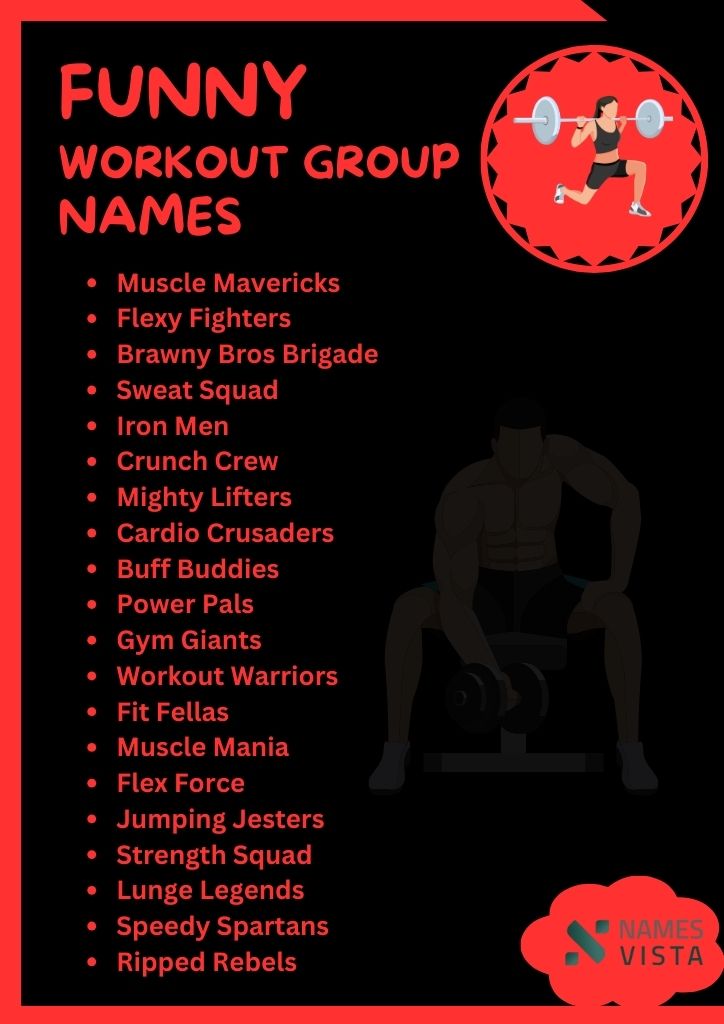
Image courtesy of namesvista.com via Google Images
Pre-Workout Nutrition
Prior to a workout, it is important to fuel your body with the right nutrients to enhance performance and prevent fatigue. Opt for a balanced pre-workout meal or snack that includes carbohydrates for energy, protein for muscle repair, and hydration to stay hydrated during your workout.
Post-Workout Nutrition
After a workout, refuel your body with a combination of protein and carbohydrates to aid in muscle recovery and replenish glycogen stores. Consider consuming a post-workout meal or snack within 30 minutes to an hour after your workout to maximize the benefits of your training session.

Image courtesy of barbend.com via Google Images
Staying Hydrated
Hydration plays a vital role in supporting your workouts and overall physical health. Make sure to drink an adequate amount of water throughout the day, especially before, during, and after your workouts. Dehydration can negatively impact your performance and recovery, so prioritize staying hydrated at all times.
Rest and Recovery
Rest and recovery are essential components of any effective workout plan. Adequate rest allows your muscles to repair and grow, reducing the risk of injury and preventing burnout. Incorporate rest days into your workout routine and listen to your body’s signals to ensure you give yourself the recovery time needed for peak performance.
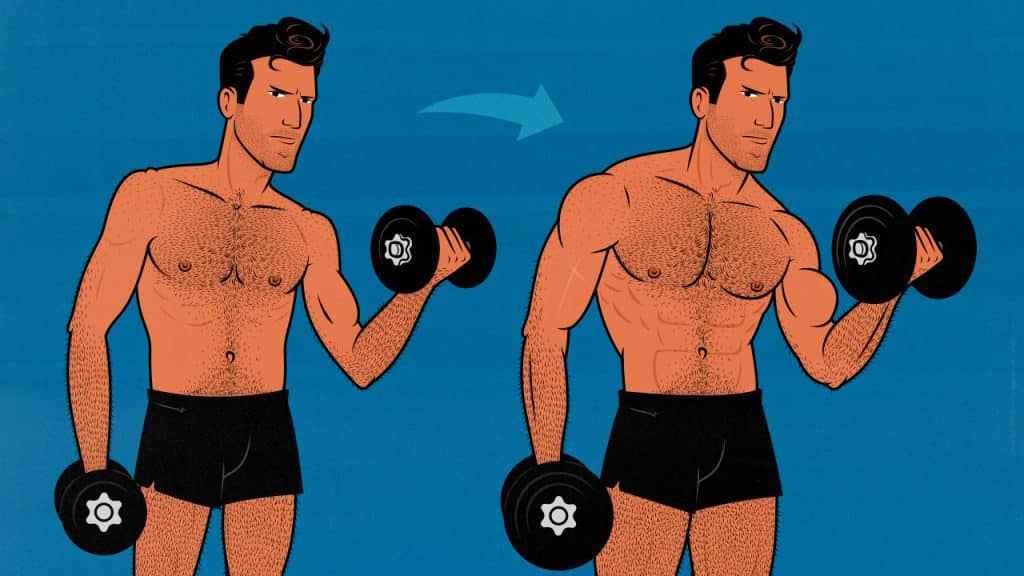
Image courtesy of bonytobeastly.com via Google Images
Tracking Progress
Tracking your progress is a great way to stay motivated and measure your success. Keep a workout journal, use fitness apps, or take progress photos to monitor your achievements and make adjustments to your workout and nutrition plan as needed. Celebrate your victories, no matter how small, and stay committed to your fitness goals.
Conclusion
Crafting the ultimate gym plan for peak performance requires a combination of effective workouts and proper nutrition. By setting realistic fitness goals, creating a balanced workout routine, choosing the right nutrition plan, and prioritizing hydration, rest, and recovery, you can optimize your performance and reach your fitness aspirations. Stay committed to your journey, track your progress, and celebrate your achievements along the way. With dedication and persistence, you can achieve your fitness goals and unlock your full potential.
Discover the ultimate HIIT workouts that will take your fitness to the next level and have you breaking a sweat.
Table of Contents
Fitness has become a key aspect of many people’s lives, with more and more individuals recognizing the importance of incorporating exercise and proper nutrition into their daily routines. However, achieving fitness goals can often feel daunting and overwhelming. In this ultimate guide, we will provide you with tips, workout routines, and nutrition advice to help you navigate your fitness journey and reach your desired objectives.
Setting SMART Goals
Setting Specific, Measurable, Achievable, Relevant, and Time-bound (SMART) goals is essential for ensuring that you have a clear roadmap to follow in your fitness journey. By defining your goals in a SMART manner, you can better track your progress and stay motivated along the way.
Tips for Staying Motivated
Staying motivated throughout your fitness journey can be challenging, but with the right strategies, you can maintain your enthusiasm and drive. Surrounding yourself with supportive individuals, setting rewards for milestones achieved, and visualizing your success are all effective ways to stay motivated.
Effective Workouts for Different Fitness Goals
Workout routines should be tailored to your specific fitness goals, whether you’re aiming for weight loss, muscle gain, or overall fitness. We have curated a selection of workout plans for beginners, intermediate, and advanced individuals to help you achieve your desired results.

Image courtesy of dailyburn.com via Google Images
Importance of Proper Nutrition
Nutrition plays a crucial role in supporting your fitness goals and overall well-being. Choosing nutrient-dense foods that fuel your workouts and aid in recovery is vital for optimizing your performance and seeing progress in your fitness journey.
Meal Prep and Planning
Meal prepping and planning ahead can save you time and help you stay on track with your nutrition goals. By preparing healthy meals in advance, you can ensure that you have nutritious options readily available and avoid succumbing to unhealthy food choices.
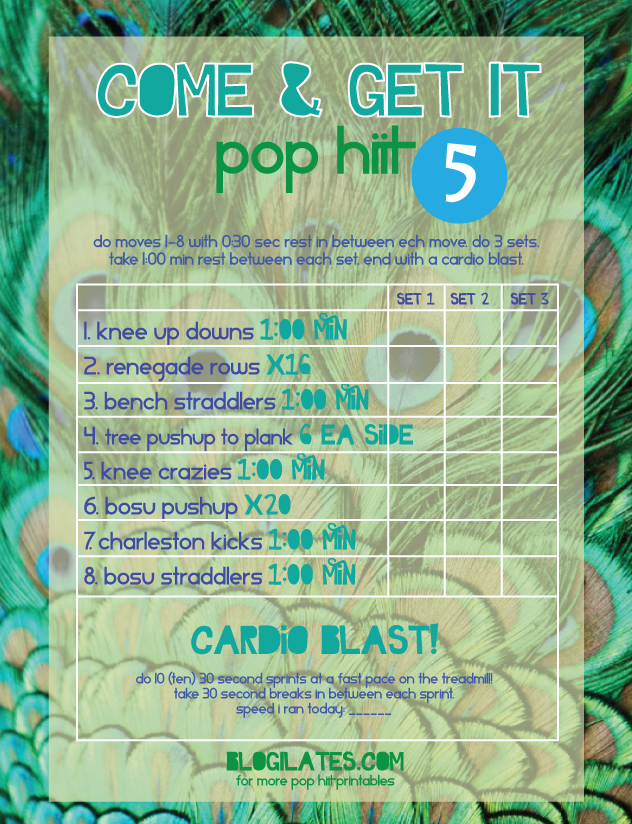
Image courtesy of www.blogilates.com via Google Images
Tracking Progress and Making Adjustments
Monitoring your progress is essential for gauging your success and making necessary adjustments to your workout and nutrition plan. By keeping track of your measurements, photos, and performance benchmarks, you can stay on course towards achieving your fitness goals.
Incorporating Supplements
Supplements can be valuable additions to your fitness routine, helping to enhance performance and aid in recovery. Before incorporating supplements, it’s essential to consult with a healthcare professional or nutritionist to determine what products may be beneficial for your individual needs.

Image courtesy of www.pinterest.co.kr via Google Images
Rest and Recovery
Rest days and proper recovery techniques are crucial for allowing your body to repair and rebuild muscle after intense workouts. Getting quality sleep, managing stress levels, and incorporating relaxation practices are all vital components of an effective rest and recovery regimen.
Gym Etiquette and Safety
Practicing good gym etiquette is essential for creating a positive workout environment for all individuals. Respect for others, cleanliness, and following safety protocols can help ensure that everyone has a safe and enjoyable experience at the gym.

Image courtesy of www.fix.com via Google Images
Celebrating Your Success
Celebrating your achievements along the way is key to staying motivated and inspired on your fitness journey. Whether it’s reaching a new personal best or hitting a significant milestone, taking time to acknowledge your progress can boost your confidence and propel you towards new goals.
Conclusion
Embarking on a fitness journey can be a transformative experience, leading to improved physical and mental well-being. By following the tips, workout routines, and nutrition advice outlined in this guide, you can set yourself up for success and work towards achieving your fitness goals. Remember to stay consistent, committed, and patient as you progress along your path to a healthier, fitter you.
Before your workout, eat a combination of carbohydrates and protein. After exercising, refuel with protein to aid muscle recovery and carbohydrates to replenish energy stores.
Choosing the right foods before and after your workout is crucial for performance and recovery. A pre-workout meal should be rich in carbohydrates, the body’s primary energy source, and include protein to prevent muscle damage. This could be a piece of fruit with a handful of nuts or yogurt with berries.
Following your workout, your body needs to repair and rebuild muscle tissue, making protein critical. You also need to restore glycogen levels, making carbohydrates important again. A lean chicken breast with brown rice or a protein shake with a banana are smart choices. Tailoring your nutrition around your fitness regime enhances performance, speeds up recovery, and contributes to overall health. Remember to stay hydrated before, during, and after exercising to support metabolic processes and aid in the transport of nutrients.
Timing Your Pre-workout Meals
Getting the timing right for your pre-workout meals is as crucial as the workout itself. Not only does it fuel your training session, it also ensures that the energy is available when your body needs it the most. There’s a delicate balance between eating too early or too late, which can make a significant difference in your performance and recovery. Let’s dive into understanding why the timing of your pre-workout meal matters.
Importance Of Eating At The Right Time
Eating at the optimal time before exercising maximizes your energy levels and minimizes discomfort during the workout. A well-timed meal can enhance performance, maintain blood sugar levels, and even increase muscle protein synthesis post-recovery. Fuel up too early, and you might find the energy waning halfway through. Too late, and your body might be digesting while you’re demanding peak performance!
How Long Before A Workout To Eat
The time required to eat before a workout largely depends on what you’re consuming. A common guideline is 30 minutes to 3 hours before your workout. This time frame allows your body to digest the meal and convert it into readily available energy. An ideal approach includes:
- A substantial meal 2-3 hours prior
- A lighter snack 30 minutes to an hour before
Keep in mind that individual digestive responses vary, so it’s essential to personalize your timing.
Examples Of Quick And Efficient Pre-workout Food
Finding the right type of food that can be digested quickly and provide sufficient energy is key. Consider these options for a quick and efficient pre-workout boost:
| Pre-Workout Time Frame | Food Examples |
|---|---|
| 2-3 Hours Before | Whole grain sandwich with lean protein, brown rice with chicken, or a quinoa and vegetable bowl. |
| 30-60 Minutes Before | Greek yogurt with fruit, a banana with almond butter, or a protein smoothie. |
Select foods that are low in fat and fiber to ensure quick digestion and prevent any gastrointestinal discomfort during your workout.
Balancing Macros For Pre-workout Fuel
Embarking on a workout routine involves more than just enthusiasm and gear. Your body is your engine and fueling it correctly is pivotal for high performance and recovery. Balancing macronutrients before you hit the gym sets the stage for optimal energy utilization and muscle support. Get the mix right, and you’ll be powering through sets and reps with finesse.
The Role Of Carbohydrates
Carbohydrates are the primary source of energy for your muscles during high-intensity workouts. They break down into glucose, entering your muscle cells and providing the fuel to power your exercise sessions. Not all carbs are equal, though. It’s essential to focus on complex carbohydrates such as whole grains, fruits, and vegetables. They ensure a steady release of energy, keeping you charged throughout your workout.
Proteins
While carbs handle the immediate energy needs, proteins are there for muscle support. Consuming proteins before working out helps prevent muscle catabolism and primes your body for muscle repair and growth post-exercise. Aiming for lean protein sources like chicken breast, tofu, or a whey protein shake can provide the necessary amino acids without the extra fat.
Fats
Fats often get a bad rap, but they are crucial in a pre-workout meal, especially for longer, endurance-focused training sessions. They can provide a slow-burning source of energy. However, moderation is key since fats take longer to digest. Including a small amount of healthy fats such as avocado, nuts, or seeds can aid sustained effort during a lengthy workout.
Ideal Macronutrient Ratios
- Carbohydrates – 55-65%
- Proteins – 10-15%
- Fats – 25-30%
These ratios can change depending on the individual’s goals, the type of workout, and tolerance. It’s about finding the balance that works for you.
Foods To Avoid Before Hitting The Gym
Not all foods will serve you well pre-workout. It’s advisable to steer clear of high-sugar, fatty, and overly fibrous foods. These can cause rapid spikes in blood sugar or sit heavily in your stomach, potentially leading to discomfort and cramping.
| Foods to Avoid | Reasons to Avoid |
|---|---|
| Refined Sugars | Can lead to energy crash |
| Heavy Proteins | Slow to digest and may cause discomfort |
| Fried Foods | High in fat and hard to digest |
Remember, the pre-workout meal isn’t about stuffing yourself but rather boosting your workout from the inside out. A balanced approach to macros tailored to your individual needs can help you achieve just that.
Quick Recovery Foods To Eat After Exercising
Your workout isn’t over when you cast aside those dumbbells or take your final jogger’s stride; it’s complete after you fuel your recovery. Choosing the right foods after exercising is crucial for replenishing energy stores, building and repairing muscles, and ensuring your body recovers efficiently and effectively. In this section, we’ll explore what to eat to kickstart your post-workout recovery, so you can get back to your workouts stronger and faster.
Why Post-workout Nutrition Is Crucial
Post-workout nutrition is paramount to recovery and performance. Consuming the right balance of nutrients after exercise helps to reduce muscle protein breakdown, increase synthesis, replenish glycogen stores, and lessen muscle soreness. In essence, it’s not just about what you lift or how far you run; it’s also about what you eat afterward, which sets the stage for your next workout.
Best Foods For Muscle Recovery
Nutrient-dense foods play a significant role in muscle repair. After a strenuous workout, your body cries out for proteins and carbohydrates to jump-start recovery:
- Protein provides amino acids which aid in repairing and rebuilding muscle tissue. Optimal choices include:
- Grilled chicken breast
- Cottage cheese
- Plant-based options like lentils and chickpeas
- Whey or plant-based protein shakes
- Carbohydrates replenish glycogen stores to boost energy and recovery. Go for:
- Quinoa
- Brown rice
- Whole grain pasta
- Fruits such as bananas or berries
Combining these macros into dishes such as a chicken quinoa bowl or cottage cheese with fruit can offer a perfect recovery meal.
The Significance Of Hydration
Hydration is an aspect of post-workout recovery that should never be overlooked. Water plays a critical role in every cellular function in your body, especially in the muscle repair process. After exercise, replacing lost fluids is a key step in recovery.
| Time After Exercise | Hydration |
|---|---|
| Immediately | Drink water or electrolyte-rich fluids |
| Within 2 Hours | Continue hydrating; ensure urine color is light yellow |
Aim for hydrating with beverages like water, coconut water, or electrolyte-infused drinks to not only replenish fluids but also return crucial minerals and salts lost through sweat back into your system.

Credit: www.everydayhealth.com
What Eat After Your Workout: Fuel & Recover!
After pushing yourself through a tough workout, your body is in a state of recovery. The right nutrition can help repair muscle tissues, replenish glycogen stores, and reduce muscle soreness. Taking in the optimal balance of nutrients after exercising is not just about eating what you fancy; it’s about fueling your body for effective recovery and future performance.
Integration Of Micronutrients And Antioxidants
Post-exercise, your body craves a variety of nutrients to kickstart the recovery process. Integrating a colorful array of fruits and vegetables can provide you with essential micronutrients and antioxidants. Antioxidants combat oxidative stress caused by workout-induced free radicals, while micronutrients like magnesium and potassium support muscle function and fluid balance.
- Vitamin C – Found in citrus fruits, bell peppers, and strawberries for immune support.
- Vitamin E – Present in nuts and seeds, advantageous for its anti-inflammatory properties.
- B Vitamins – Abundant in whole grains and lean meats, essential for energy metabolism.
- Zinc – Critical for healing and is available in meat, beans, and nuts.
Sample Post-workout Meal Plan For Various Workout Types
Your post-workout meal should cater to the type of exercise you’ve engaged in. Whether it’s a cardio session, strength training, or a mix of both, your body requires specific nutrition for recuperation.
| Workout Type | Sample Post-Workout Meal |
|---|---|
| Cardio/Swimming | A smoothie made with banana, berries, spinach, plant-based protein, and almond milk |
| Strength Training | Grilled chicken breast with quinoa and steamed vegetables |
| Yoga/Pilates | Greek yogurt topped with granola and honey |
| Mixed Workout | Whole grain wrap with turkey, avocado, and mixed greens |
Post-workout Supplements: Yay Or Nay?
Post-workout supplements can play a role in muscle recovery and energy restoration. However, they should never replace real food. Protein powders, BCAAs (branched-chain amino acids), and glutamine are popular choices. If you opt for supplements, select those without added sugars or artificial ingredients and treat them as complements to a balanced post-workout meal, rather than a substitute.
- Protein Powders: A convenient protein source when whole food is not available.
- BCAAs: May reduce muscle soreness and improve recovery, especially for intense training.
- Glutamine: Supports immune function and gut health, which may be beneficial during recovery phases.
Remember, it’s essential to listen to your body and provide it with wholesome nutrition. Tailor your post-workout meal to suit your dietary preferences, workout intensity, and individual health goals.
Personalizing Your Pre And Post-workout Meals
Fueling your body for a workout and replenishing it afterwards requires a personalized approach tailored to your fitness goals, biological differences, and the type of exercise you engage in. While there’s no one-size-fits-all answer, understanding the basics can help you customize your meal plans to optimize performance and recovery.
Eating For Weight Loss Vs. Muscle Gain
The objective of your workout significantly influences your nutritional intake. If you’re aiming to lose weight, your pre-workout meal should be light and comprise low-calorie, nutrient-dense foods that provide energy without excess. Post-workout, target a balance of lean protein and complex carbohydrates to aid in recovery while maintaining a calorie deficit.
- For weight loss:
- Pre-workout: A small serving of whole grains with a side of fruits.
- Post-workout: Grilled chicken with steamed vegetables.
- For muscle gain:
- Pre-workout: Brown rice with black beans for sustained energy.
- Post-workout: Protein shake with banana and a scoop of peanut butter.
Gender-based Nutritional Differences
Men and women often require different nutritional strategies. While the fundamental principles of sports nutrition apply to everyone, hormonal variations can play a role in how the body metabolizes nutrients. Men may benefit from a higher intake of calories and protein, especially for muscle synthesis, while women should focus on iron-rich foods to compensate for iron loss.
| Nutrient | Men | Women |
|---|---|---|
| Calories | Higher | Moderate |
| Protein | Higher | Moderate |
| Iron | Lower | Higher |
Adjusting Meals For Endurance Vs. Strength Training
Your meal composition should reflect the nature of your training. Endurance athletes require a higher proportion of carbohydrates for sustained energy, whereas strength training demands more protein for muscle repair and growth. Understand and listen to your body’s cues to adjust the balance of macronutrients accordingly.
-
- Pre-workout: Oatmeal topped with berries.
- Post-workout: Whole-grain sandwich with turkey and avocado.
-
- Pre-workout: Omelette with spinach and whole grain toast.
- Post-workout: Quinoa bowl with mixed vegetables and grilled salmon.
Debunking Common Pre And Post Fuel Misconceptions
Fueling your body appropriately before and after workouts is crucial for maximizing performance and recovery. However, a wealth of misinformation leads many fitness enthusiasts to make less-than-optimal nutrition choices. We’re here to dismantle some of the most pervasive myths and set the record straight with facts that will help you nourish your body right in your fitness journey.
Myth Vs. Fact: Fasting Workouts
The myth: Working out on an empty stomach will help you burn more fat and lose weight more effectively. The fact: While there’s some evidence to support the idea that fasting can lead to higher fat oxidation, this doesn’t necessarily translate to long-term weight loss or better performance. Working out without any fuel can actually lead to muscle breakdown and reduced endurance.
- Listen to your body: Some individuals may feel fine during a fasted workout, while others may feel dizzy or lethargic. Pay attention to your body’s signals.
- Type of workout matters: High-intensity or long-duration workouts typically require pre-workout fuel for optimal performance.
- Balanced approach: If you prefer fasted workouts, consider a small, easily digestible snack like a banana or a handful of almonds if you feel you need some energy.
The Truth About Protein Timing
The myth: You need to consume protein immediately after a workout, or you’ll miss the ‘anabolic window.’ The fact: Research has shown that the body’s window to benefit from protein can last up to 24 hours post-workout. While it’s still important to intake protein after exercising, the urgency isn’t as critical as once thought.
| Time Frame | Importance of Protein Intake |
|---|---|
| 0-2 hours post-workout | Beneficial for immediate recovery, but not mandatory |
| 24 hours post-workout | Muscle repair and growth can still occur when protein is consumed within this time frame |
Quality over timing: Focus on the overall quality and quantity of protein in your diet. Ensure consistent intake throughout the day to support muscle repair and growth.
Clearing Up Carbohydrate Confusions
The myth: Carbs are bad, and you should avoid them after a workout. The fact: Carbohydrates are actually vital post-workout as they replenish muscle glycogen stores, which have been depleted during exercise. They also work hand-in-hand with protein to enhance recovery.
- Refuel properly: Aim for a post-workout meal with both carbs and protein; for example, a turkey and cheese sandwich on whole-grain bread is a balanced choice.
- Quality of carbs: Opt for complex carbohydrates like oatmeal, quinoa, or sweet potatoes instead of refined sugars.
- Carbs for different goals: The amount and type of carbohydrates needed can vary based on your fitness goals, whether it’s muscle gain, weight loss or endurance training.
Remember, what you eat before and after your workout should support your energy needs, performance goals, and recovery process. With the myths debunked and facts laid out, you’re better equipped to make informed nutrition decisions that align with your fitness regimen.
Conclusion
Fueling your body appropriately for exercise is crucial. Opt for lean proteins, complex carbohydrates, and hydrating fluids that boost energy and aid recovery. Tailoring intake to your specific workout routine maximizes benefits. Remember, the right foods at the right time can make all the difference to your fitness goals.
Stay consistent, and enjoy the journey to a healthier you!
Unlock the secrets to crafting irresistible blog titles that will captivate your audience and boost your readership like never before.
Table of Contents
When it comes to achieving a balanced workout routine with proper nutrition, there are several factors to consider to ensure you are reaching your fitness goals effectively. In this blog post, we will explore the importance of combining a well-rounded workout routine with the right nutrition plan, and provide practical tips on how to create a gym plan that works for you.
Benefits of a Balanced Workout Routine
A balanced workout routine that includes a mix of cardio, strength training, and flexibility exercises can help improve overall fitness levels and assist in achieving specific fitness goals. Cardio exercises improve cardiovascular health, burn calories, and boost endurance, while strength training helps build muscle mass, increase metabolism, and improve overall strength. Incorporating flexibility exercises can help increase range of motion, prevent injuries, and improve posture.
Importance of Nutrition
Nutrition plays a crucial role in fueling workouts, aiding in muscle recovery, and supporting overall health and wellness. Consuming a balanced diet that includes a mix of carbohydrates, protein, healthy fats, vitamins, and minerals is essential for providing the necessary energy for workouts, repairing muscle tissue post-exercise, and maintaining overall health.
Tips for Pre-Workout Nutrition
Before a workout, it’s important to fuel your body with the right nutrients to optimize performance. Consuming a combination of carbohydrates and protein can help sustain energy levels during the workout. Foods like whole grains, fruits, lean protein sources, and nuts can be great options for pre-workout snacks.

Image courtesy of www.theedublogger.com via Google Images
Tips for Post-Workout Nutrition
After a workout, refueling your body with nutrients is essential for muscle recovery and replenishing energy stores. Consuming a meal or snack that includes a mix of protein and carbohydrates can help repair muscle tissue and restore glycogen levels. Foods like lean meats, eggs, quinoa, and sweet potatoes are great choices for post-workout meals.
Creating a Gym Plan
When creating a gym plan, it’s important to consider your fitness goals, schedule, and preferences. Building a workout routine that includes a mix of cardio, strength training, and flexibility exercises can help keep things interesting and target different muscle groups effectively. Consulting with a fitness professional can also help tailor a gym plan to your specific needs.
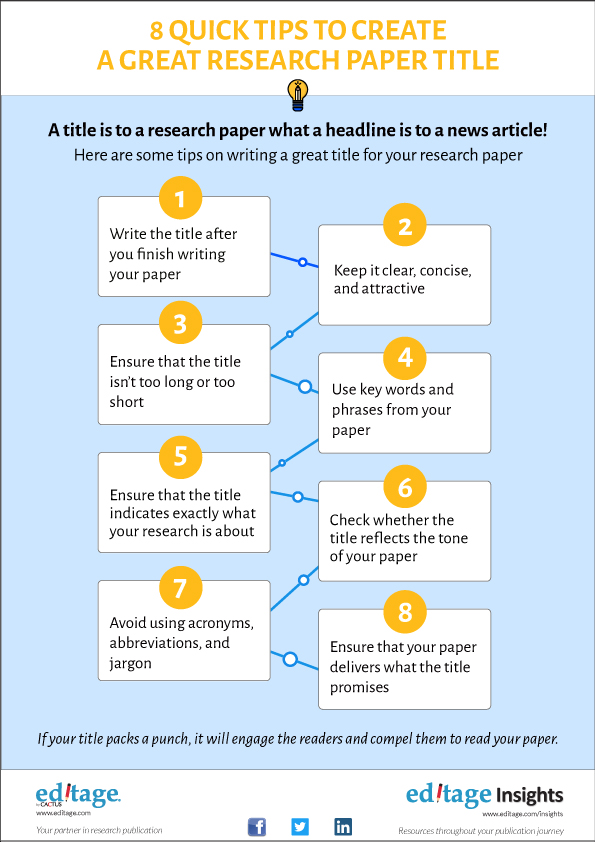
Image courtesy of www.editage.com via Google Images
Balancing Cardio and Strength Training
Both cardio and strength training play important roles in a well-rounded workout routine. Cardio exercises help improve cardiovascular health, while strength training builds muscle mass and boosts metabolism. Balancing these two types of exercises can help achieve a lean and toned physique, and prevent plateaus in your fitness progress.
Importance of Rest and Recovery
Rest and recovery are crucial aspects of any workout routine. Taking rest days allows your muscles to recover and repair, reducing the risk of overtraining and injury. Proper recovery techniques such as stretching, foam rolling, and adequate sleep can help optimize your workout performance and overall health.

Image courtesy of medium.com via Google Images
Tracking Progress
Tracking your progress in the gym can help you stay motivated and make necessary adjustments to your workout routine. Keeping a workout journal, taking measurements, and monitoring performance improvements can provide valuable insights into your fitness journey and help you set new goals to continue progressing.
In conclusion, achieving a balanced workout routine with proper nutrition is key to reaching your fitness goals and maintaining overall health and wellness. By incorporating a mix of cardio, strength training, and flexibility exercises into your gym plan, fueling your body with the right nutrients, and prioritizing rest and recovery, you can optimize your workout performance and see lasting results. Remember to listen to your body, stay consistent, and seek guidance from fitness professionals when needed to ensure you are on the right track towards a healthier and fitter lifestyle.
Discover the powerful workout routines that will revolutionize your fitness journey and help you crush your goals like never before.
Table of Contents
In today’s fast-paced world, prioritizing your health and wellness can sometimes take a back seat. However, incorporating regular exercise, a balanced diet, and a personalized gym plan can have long-lasting benefits on your overall well-being. This blog post will provide you with valuable workout tips, nutrition advice, and a tailored gym plan to help you reach your fitness goals.
Workout Tips
When it comes to working out, incorporating a variety of exercises is key to achieving optimal results. Cardiovascular exercises not only help improve your heart health but also burn calories and increase your endurance. Some great cardio workouts to try include running, cycling, or swimming.
Additionally, don’t underestimate the power of strength training. Building muscle not only boosts your metabolism but also helps improve bone density and posture. Incorporating exercises like squats, deadlifts, and push-ups into your routine can help you build strength and muscle mass.
Finally, don’t forget about flexibility and stretching exercises. Flexibility not only improves your range of motion but also reduces the risk of injury. Consider adding yoga or Pilates to your workout routine to improve flexibility and balance.
Nutrition Advice
Eating a well-balanced diet is crucial for fueling your workouts and promoting overall health. Aim to incorporate a variety of fruits, vegetables, whole grains, lean proteins, and healthy fats into your meals. Avoid processed foods and sugary drinks, which can spike your blood sugar levels and lead to energy crashes.
Staying hydrated is also essential for optimal performance. Drink plenty of water throughout the day, especially before and after your workouts. Proper hydration helps regulate body temperature, transport nutrients, and remove waste from the body.
Gym Plan
Creating a personalized gym plan is key to staying motivated and consistent with your fitness goals. Start by setting realistic and achievable goals for yourself. Whether you’re looking to lose weight, build muscle, or improve your endurance, having a clear goal in mind can help keep you on track.
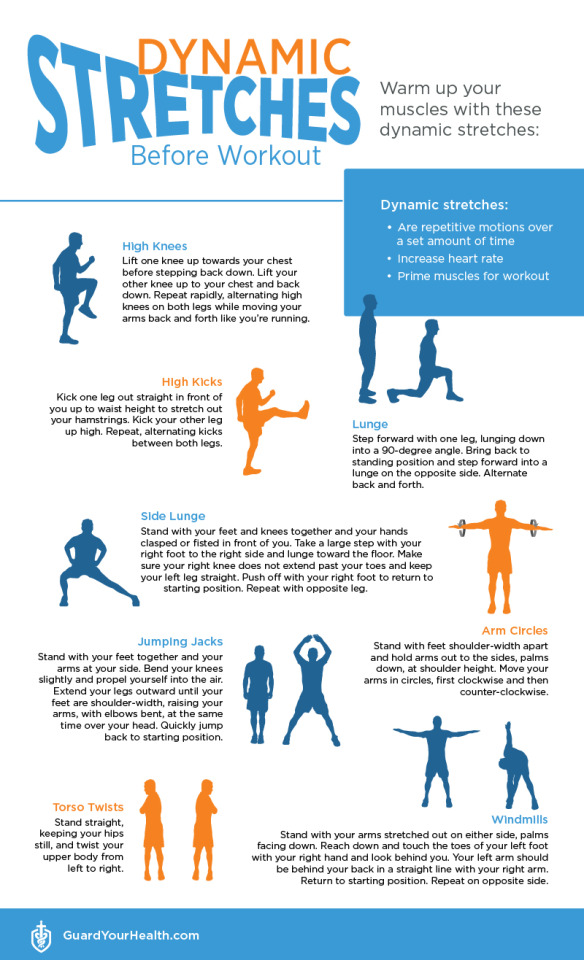
Image courtesy of guardyourhealth.tumblr.com via Google Images
Next, create a workout schedule that fits your lifestyle and preferences. Consider factors such as time of day, duration of workouts, and frequency of training. Finding a routine that works for you will make it easier to stick to your plan in the long run.
Utilize gym equipment effectively to maximize your workouts. Whether you’re using free weights, resistance bands, or cardio machines, make sure you’re using proper form and technique to prevent injury and get the most out of your exercises.
Conclusion
In conclusion, incorporating workout tips, nutrition advice, and a personalized gym plan into your lifestyle can have a significant impact on your overall health and well-being. By following the tips outlined in this blog post, you can take steps towards achieving your fitness goals and living a healthier, happier life.
Discover the ultimate gym plan that will revolutionize your body in just 12 weeks – prepare to transform yourself!
Table of Contents
When it comes to maximizing your workout results, it’s crucial to pay attention to various aspects such as workout tips, nutrition, and a well-structured gym plan. By incorporating these elements into your routine, you can achieve your fitness goals more effectively and efficiently. In this comprehensive guide, we will explore the key components of a successful workout regimen and provide you with practical advice on how to optimize your fitness journey.
Workout Tips
One of the most critical aspects of a successful workout routine is following effective tips that can help you get the most out of your exercise sessions. Here are some key workout tips to keep in mind:
- Warm Up and Cool Down: Always start your workout with a proper warm-up to prepare your body for exercise and reduce the risk of injury. Similarly, remember to cool down after your workout to help your muscles recover.
- Cardio and Strength Training: Incorporate a mix of cardiovascular exercises and strength training to target different muscle groups and improve overall fitness.
- Goal Setting: Set realistic fitness goals for yourself and track your progress regularly to stay motivated and focused on your objectives.
Nutrition
Proper nutrition plays a significant role in supporting your workout efforts and helping you achieve optimal results. Consider the following nutrition tips to enhance your fitness journey:
- Pre-Workout Meals: Fuel your body with a balanced meal or snack before your workout to provide the necessary energy for exercise.
- Post-Workout Nutrition: Consume a meal or snack rich in protein and carbohydrates after your workout to support muscle recovery and replenish energy stores.
- Hydration: Stay hydrated throughout the day by drinking an adequate amount of water to support your physical performance and overall health.
Gym Plan
Creating a well-rounded gym plan is essential for achieving your fitness goals and maintaining a consistent workout routine. Follow these tips to design an effective gym plan:

Image courtesy of www.pinterest.com via Google Images
- Workout Schedule: Develop a balanced workout schedule that includes a mix of cardio, strength training, and flexibility exercises to target different fitness components.
- Rest Days: Incorporate rest days into your gym plan to allow your muscles to recover and prevent burnout from overtraining.
- Flexibility and Mobility: Include stretches and mobility exercises in your gym plan to improve flexibility, reduce the risk of injury, and enhance overall performance.
Finding Motivation
Maintaining motivation throughout your fitness journey is crucial for staying consistent with your workout regimen and achieving your goals. Consider the following strategies to stay motivated:
- Goal Setting: Set specific, measurable, and achievable fitness goals to keep you focused and driven on your path to success.
- Workout Community: Join workout classes, find a workout buddy, or connect with a fitness community to support and motivate each other in your fitness journey.
- Rewards System: Reward yourself for achieving milestones in your fitness journey to celebrate your progress and reinforce positive behavior.
Utilizing Apps and Fitness Trackers
Technology can be a valuable tool in supporting your fitness goals and keeping you on track with your workout routine. Consider using fitness apps and trackers to:
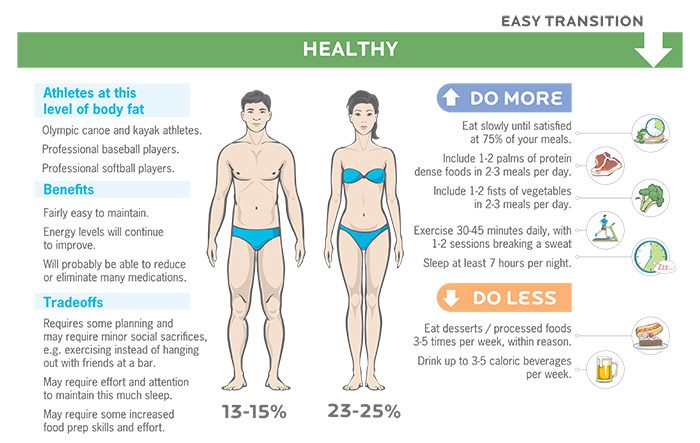
Image courtesy of www.precisionnutrition.com via Google Images
- Track Workouts and Progress: Monitor your workout sessions, track your progress, and adjust your fitness plan as needed based on your results.
- Access Workout Routines: Find new workout routines, exercise programs, and meal plans tailored to your fitness goals and preferences.
- Connect with a Fitness Community: Engage with a fitness community online to share experiences, seek advice, and find motivation in your fitness journey.
Monitoring Progress
Regularly monitoring your progress is essential for assessing the effectiveness of your workout plan and making necessary adjustments to achieve your fitness goals. Keep track of your workouts and nutrition intake to:
- Track Workouts: Record your workout sessions, including exercises, sets, reps, and weights, to ensure progress and consistency in your training.
- Assess Nutrition: Monitor your daily food intake, macronutrient balance, and hydration levels to support your workout performance and overall health.
- Celebrate Achievements: Celebrate your fitness achievements, no matter how small, and use them as fuel to stay motivated and continue making progress in your fitness journey.
Seeking Professional Help
If you’re new to fitness or looking to take your workout routine to the next level, consider seeking professional guidance to optimize your training program. Here are some options to consider:
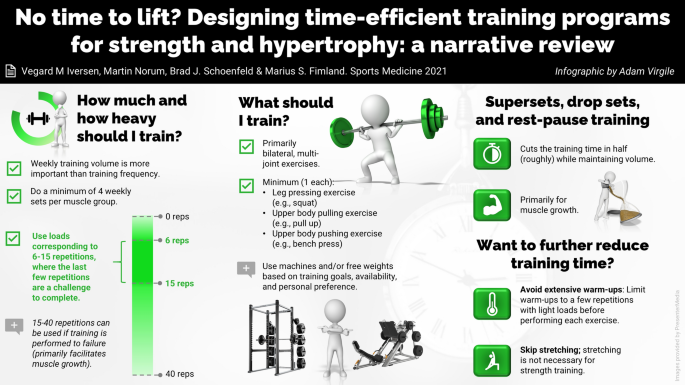
Image courtesy of link.springer.com via Google Images
- Personal Trainer: Work with a certified personal trainer who can design personalized workouts, provide expert guidance, and help you reach your fitness goals effectively.
- Nutritionist: Consult with a registered nutritionist to receive customized meal plans, dietary recommendations, and nutritional guidance to support your fitness journey.
- Workout Assessment: Schedule a workout assessment with a fitness professional to evaluate your current fitness level, identify areas for improvement, and develop a tailored workout plan.
Incorporating Variety
Adding variety to your workout routine can keep things exciting, prevent boredom, and challenge your body in different ways. Consider the following tips to incorporate variety into your fitness regimen:
- Try New Workouts: Experiment with different workout styles, classes, and activities to keep your routine engaging and discover what works best for you.
- Explore Different Exercises: Incorporate a mix of cardio, strength training, flexibility, and balance exercises to target various muscle groups and improve overall fitness.
- Mix Up Nutrition: Explore new recipes, ingredients, and meal plans to keep your nutrition varied, balanced, and enjoyable while supporting your fitness goals.
Conclusion
By integrating effective workout tips, proper nutrition, and a well-structured gym plan into your fitness routine, you can maximize your workout results, achieve your fitness goals, and transform your body in 12 weeks. Stay consistent, motivated, and focused on your health and well-being to make the most out of your fitness journey. Remember, every step you take toward your fitness goals is a step closer to becoming the best version of yourself.



